- Bruce Rich
- Environmental Forum
- January/February 2022
- 23
At COP 26 scores of nations endorsed ambitious voluntary side agreements full of loopholes. Over 120 nations with 85 percent of the world’s forests pledged “to halt and reverse forest loss and land degradation by 2030.” The agreement gave no detail, wrote the Financial Times, of “how [its] implementation would be tracked, or what might happen if nations reneged.” Indonesia signed, but then its environment and forestry minister called any commitment to halt deforestation “inappropriate and unfair.” The agreement reiterated the failed 2014 New York Declaration on Forests, where 40 countries, including the Democratic Republic of the Congo, Indonesia, and several Brazilian Amazon states, pledged to halve forest loss globally by 2020 and end it by 2030. Yet since 2104 the loss of tropical forests increased, and many signatories ignored the 2014 pledge in mitigation plans under the 2015 Paris Climate Agreement.
A U.S. and EU initiative to reduce methane emissions 30 percent by 2030 was endorsed by more than 100 countries. The planet’s three largest methane emitters, China, India, and Russia, refused to sign.
Coal is still responsible for 40 percent of annual global CO2 emissions. To limit global warming to 1.5 degrees Celsius,the head of the International Energy Agency warned that 40 percent of the world’s existing 8,500 coal plants must close by 2030, and no new ones must be built. Richer nations pledged in the coal agreement signed by 40 countries to end coal use “by 2030 or as soon as possible afterwards, and developing countries “by 2040 or as soon as possible afterwards.” There isn’t a clue what “as soon as possible” really means. Coal exporter Australia, and China, India, and the US, representing 72 percent of world coal power emissions, did not sign.



